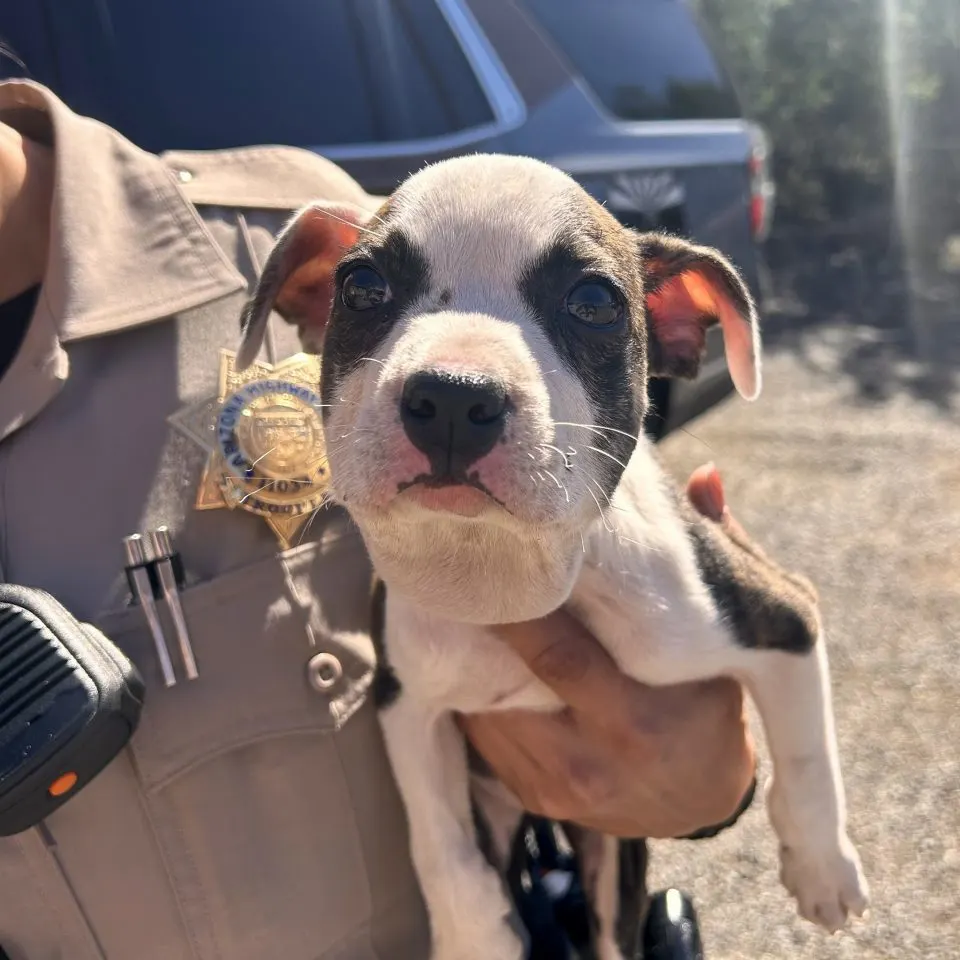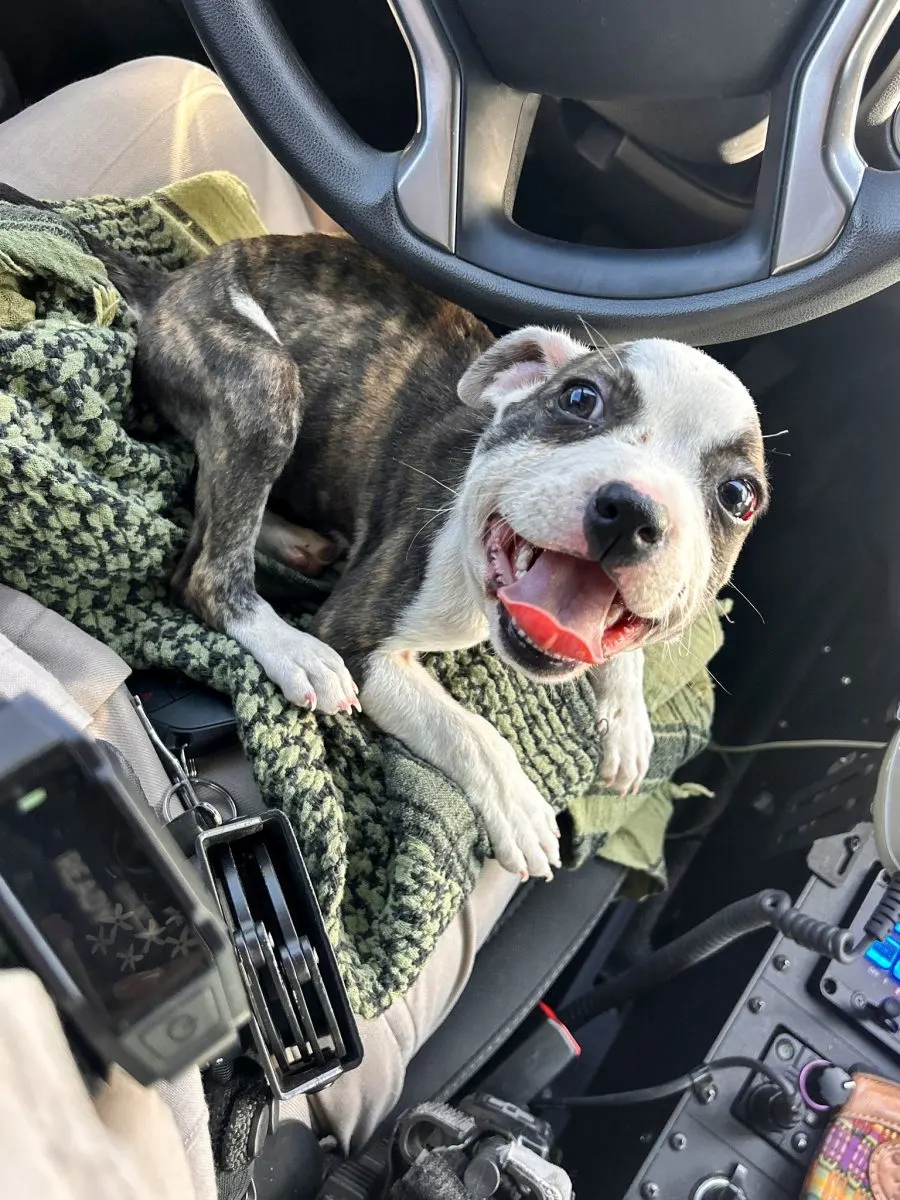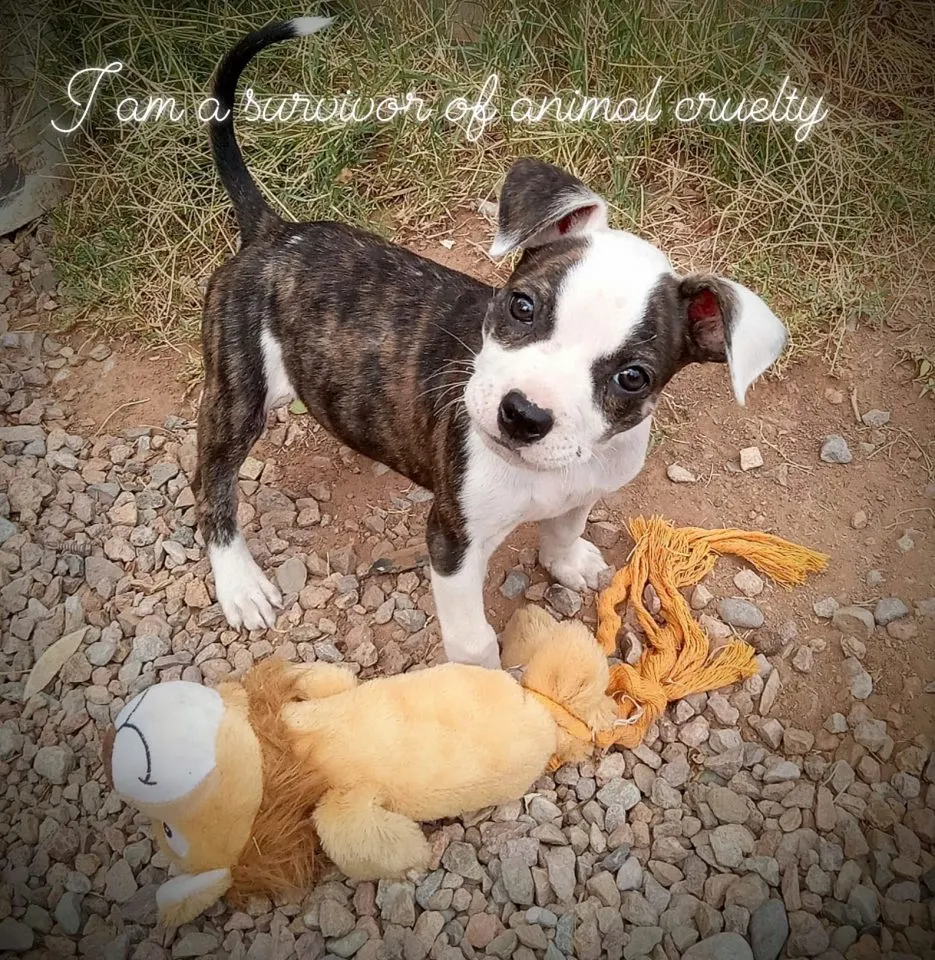From the moment our pups enter our life, we strive to give them the best possible life. The love that we shower them with makes them blossom into happy dogs. They feel safe and loved, knowing that we will always be there for them.
My heart sinks every time I hear about the ruthless dog owners who lack empathy and abuse their precious canines. These bad humans subject their dogs to cruelty and abandon them in dangerous places without the tiniest bit of remorse.
Today, we’ll talk about Brandy… a dog who went through such an ordeal after she was abandoned on the highway.
The Adorable Puppy In Need Of Help

While a truck driver was driving on the highway in Benson, Arizona, a strange sight attracted his attention and made him hit the brakes.
They noticed a little white spot lying on an Interstate 10 exit ramp. As they approached, they were shocked to realize that it was a puppy who desperately needed their help. She had a zip tie tightly attached around her neck.
The truck driver was heartbroken and they couldn’t understand how somebody could be so inhumane and dump the dog, putting his life in danger.
The giant-hearted human rushed to help the little girl, and they quickly removed the zip tie from her neck. The puppy felt relieved that a good human spotted her in time.
The puppy’s rescuer gave her some water to drink and kept her company.
They called for help, and shortly afterward, a trooper, Iliana Magallanes, arrived at the scene.
The trooper was deeply saddened after she saw the dog’s red eyes and swollen neck. The pup was thrilled to see her coming, and she began wagging her tail.
“[She was] still friendly and happy despite her ordeal,” Arizona Department of Public Safety wrote.
Magallanes carried the puppy to her car, hoping that she would soon forget everything she had been through.

On their way to Benson Animal Shelter, Paws And Claws, the trooper did her best to comfort the tiny puppy. She covered her with a blanket and reassured her that she was now safe.
The puppy, who was later named Brandy, had a wide smile on her face as she looked at Magallanes. Her eyes glimmered with joy because good humans found her and decided to help her.
Brandy Found Her Forever Home

As soon as she arrived at the shelter, Brandy was given a medical checkup. After she received the proper treatment, she went to a foster home.
Her foster family knew that the pooch would need some time to recover from her neck injury. They took great care of Brandy and showered her with love.
Thankfully, the adorable pup is doing great. She loves sleeping in her bed and playing with her toys.

The cute puppy found her forever family. As soon as she makes a complete recovery, she will ride into the sunset with her parents. She can’t wait to move in with them and cover them in kisses.
We have no doubt that Brandy will be adored and spoiled just as much as she deserves.
Many thanks to the truck driver who rescued sweet Brandy and to all the people who helped her. You are our true heroes.
If you’ve ever spent time around dogs, you’ve probably noticed that they pant—a lot. It’s a common sight, especially after playtime or a long walk. But have you ever wondered why they do it? Understanding why dogs pant goes beyond just cooling them down; it’s a fascinating insight into their biology and behavior.
When your furry companion starts panting, it’s more than just a way to catch their breath. Dogs pant for various reasons, and each pant tells a story about how they regulate their body temperature, communicate their emotions, and even signal potential health issues. So, the next time you see your four-legged friend panting away, remember, there’s more to it than meets the eye.
Understanding Panting in Dogs
Importance of Panting
Panting in dogs is a critical physiological process that serves various essential functions beyond just cooling them down. It plays a vital role in helping dogs regulate their body temperature efficiently, especially when they are unable to sweat like humans.
Communication through Panting
Dogs often use panting as a form of communication to express their emotions and feelings. Whether they are feeling anxious, excited, or stressed, panting can indicate their state of mind to you. Understanding these cues can help you better respond to your furry companion’s needs.
Health Indicator
Pay close attention to your dog’s panting patterns as it can also be a sign of underlying health issues. Excessive or abnormal panting could signal pain, discomfort, or potential medical conditions that require prompt attention from a veterinarian.
Activity and Panting
The level of panting can vary based on your dog’s activity level. After rigorous exercise or play, dogs pant to cool down and regulate their body temperature. It’s their way of releasing excess heat and preventing overheating.
Providing Comfort
In situations where your dog is panting excessively due to heat, stress, or excitement, ensure they have access to fresh water and a cool, comfortable environment. By addressing the underlying cause of panting, you can help keep your canine companion happy and healthy.
Keep a keen eye on your dog’s panting behavior to better understand their needs, emotions, and overall well-being. Remember, proper attention to their panting can contribute to a healthier and happier life for your beloved pet.
The Physiology Behind Dog Panting
Dog panting is a vital physiological mechanism that serves multiple purposes essential for their well-being. Understanding the science behind why dogs pant can help you better care for your furry companion.
- Regulation of Body Temperature:
When your dog pants, it’s not just about cooling down. Dogs don’t sweat like humans; panting helps them regulate their body temperature. It allows moisture to evaporate from their tongue and the lining of their lungs, helping them stay cool. - Signaling Emotions and Stress Levels:
Dog panting can also be a way for them to communicate their emotions. Excessive panting might indicate anxiety or excitement. Being aware of your dog’s panting patterns can help you gauge their emotional state. - Indicator of Health Issues:
While panting is normal, excessive or sudden changes in panting behavior can signal underlying health issues. It’s crucial to monitor your dog’s panting and consult a veterinarian if you notice any unusual patterns. - Activity Levels and Panting:
The level of panting correlates with your dog’s activity levels. After exercise or during play, panting is natural as they work to cool themselves down. However, if panting persists long after activity or occurs at rest, it’s worth investigating.
Understanding why dogs pant can deepen your connection with your pet and ensure you provide the care they need for a healthy and happy life. Paying attention to their panting behavior can offer valuable insights into their well-being.
Common Triggers for Dog Panting
Physical Exercise:
Regular physical activity like long walks or play sessions can lead to panting in dogs. It’s their way of cooling down after getting their heart rate up. Ensure they have access to water during and after exercise to stay hydrated.
Heat and Humidity:
Hot weather and high humidity levels can make dogs pant more to regulate their body temperature. Provide shade and water to help them cool off. Never leave a dog in a parked car, even for a few minutes.
Stress and Anxiety:
Just like humans, dogs can pant when they’re stressed or anxious. Loud noises, new environments, or separation can trigger panting. Create a safe and calm space for your dog to help reduce their anxiety levels.
Medical Conditions:
Certain medical conditions such as heart problems, respiratory issues, pain, or fever can cause excessive panting in dogs. If you notice persistent or abnormal panting, consult your veterinarian for a thorough examination.
Overheating:
When dogs overheat, they pant excessively to try and cool down. Signs of overheating include excessive drooling, lethargy, and glazed eyes. Move your dog to a cool area and offer water to prevent heatstroke.
Excitement:
Excitement, whether from seeing their favorite human or getting ready for a walk, can also trigger panting in dogs. It’s a natural response to heightened emotions and usually subsides once they calm down.
Breeds:
Certain dog breeds, especially brachycephalic breeds like Bulldogs or Pugs, are more prone to panting due to their unique respiratory anatomy. Be mindful of their breathing patterns and avoid strenuous exercise in hot weather.
Pain:
Dogs in pain may pant as a sign of discomfort. Monitor for other signs of pain like limping or whining. If panting persists and is accompanied by other symptoms, seek veterinary help promptly.
Medications:
Some medications can cause side effects like increased panting in dogs. If your dog starts panting excessively after starting a new medication regimen, consult your vet about potential alternatives or adjustments.
Aging:
As dogs age, their panting patterns may change. Senior dogs may pant more due to decreased physical activity, changes in metabolism, or underlying health issues. Regular check-ups can help address any age-related concerns.
Tips to Manage Dog Panting
1. Provide Adequate Water:
Ensure your furry companion has access to fresh water, especially during physical activities, hot weather, or when they exhibit signs of panting. Dehydration can worsen panting, so keep their water bowl filled.
2. Offer a Cool Environment:
Create a cool and shady space for your pup, especially in warm weather. This can help reduce excessive panting caused by overheating. Consider using fans or air conditioning to help keep them comfortable.
3. Calm Stressful Situations:
If your dog gets anxious easily, try to minimize stress triggers. Calm environments can help reduce panting due to anxiety or excitement. Providing a safe space or using calming aids can also be beneficial.
4. Seek Veterinary Advice:
Persistent or abnormal panting may indicate an underlying health issue. If you notice unusual panting patterns, it’s essential to consult your vet for a thorough check-up. Professional guidance can help address any medical concerns.
5. Monitor Breeds Prone to Panting:
Certain dog breeds are more prone to panting due to their anatomy or genetic predisposition. Be aware of your dog’s breed characteristics and understand that some breeds pant more frequently than others.
6. Address Aging-Related Changes:
As dogs age, they may pant more due to reduced mobility, metabolism changes, or underlying health conditions. Keep an eye on your senior dog’s panting patterns and consult your vet if you notice any significant changes.
7. Avoid Overexertion:
During exercise, be mindful of your dog’s activity levels to prevent excessive panting. Allow for adequate rest breaks, especially in hot weather. Overexertion can lead to panting, so adjust activities accordingly.
8. Limit Exposure to Heat:
High temperatures can cause dogs to pant heavily. Avoid leaving your dog in hot cars or exposed to direct sunlight for extended periods. Always provide shade and avoid strenuous activities during peak heat hours.
9. Evaluate Medication Effects:
Certain medications may contribute to increased panting as a side effect. If your dog is on medication and experiences unusual panting, consult your vet for guidance on managing this issue.
Conclusion
That’s the scoop on why dogs pant! Remember, panting is more than just a way for them to cool down. It’s their way of expressing themselves and letting you know if something’s up. By keeping an eye on their panting habits and knowing the triggers, you can ensure your furry friend stays happy and healthy. From providing plenty of water to keeping them cool and relaxed, there are simple ways to manage panting. And don’t forget, if you notice anything unusual or concerning about your dog’s panting, it’s always best to consult with your vet. Understanding why your dog pants is the first step in taking good care of them.
Frequently Asked Questions
Why do dogs pant?
Dogs pant to regulate their body temperature, communicate emotions such as excitement or anxiety, and indicate potential health issues. It’s a natural cooling mechanism that helps them cool down when they’re hot or after physical activity.
What are the common triggers for dog panting?
Common triggers for dog panting include exercise, warm weather, stress or anxiety, and underlying medical conditions such as respiratory problems, obesity, or heart issues.
How can I help manage my dog’s panting?
You can help manage your dog’s panting by ensuring they have access to fresh water, keeping them in a cool environment, addressing their stress or anxiety triggers, seeking veterinary advice for abnormal panting, monitoring breeds prone to panting, adjusting for aging-related changes, preventing overexertion and heat exposure, and monitoring the effects of any medications they may be on.
[no_toc]

Hey there, I’m Janet Brooks, a dog-loving student from California. I’m all about helping pups in need, especially those without homes. Me and my awesome friends work together to give shelter and love to stray dogs. Oh, and I also write blogs about dogs to share helpful info.